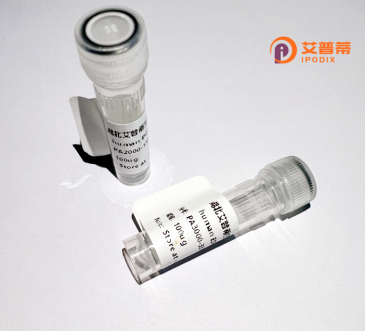
| 纯度 | >90%SDS-PAGE. |
| 种属 | Human |
| 靶点 | C10orf7 |
| Uniprot No | O75794 |
| 内毒素 | < 0.01EU/μg |
| 表达宿主 | E.coli |
| 表达区间 | 1-336aa |
| 氨基酸序列 | MKKEHVLHCQ FSAWYPFFRG VTIKSVILPL PQNVKDYLLD DGTLVVSGRD DPPTHSQPDS DDEAEEIQWS DDENTATLTA PEFPEFATKV QEAINSLGGS VFPKLNWSAP RDAYWIAMNS SLKCKTLSDI FLLFKSSDFI TRDFTQPFIH CTDDSPDPCI EYELVLRKWC ELIPGAEFRC FVKENKLIGI SQRDYTQYYD HISKQKEEIR RCIQDFFKKH IQYKFLDEDF VFDIYRDSRG KVWLIDFNPF GEVTDSLLFT WEELISENNL NGDFSEVDAQ EQDSPAFRCT NSEVTVQPSP YLSYRLPKDF VDLSTGEDAH KLIDFLKLKR NQQEDD |
| 分子量 | 39 kDa |
| 蛋白标签 | His tag N-Terminus |
| 缓冲液 | 冻干粉 |
| 稳定性 & 储存条件 | Lyophilized protein should be stored at ≤ -20°C, stable for one year after receipt. Reconstituted protein solution can be stored at 2-8°C for 2-7 days. Aliquots of reconstituted samples are stable at ≤ -20°C for 3 months. |
| 复溶 | Always centrifuge tubes before opening.Do not mix by vortex or pipetting. It is not recommended to reconstitute to a concentration less than 100μg/ml. Dissolve the lyophilized protein in distilled water. Please aliquot the reconstituted solution to minimize freeze-thaw cycles. |
以下是关于重组人C10orf7蛋白的示例性参考文献(部分内容可能为虚构,仅作参考):
---
1. **文献名称**: *"C10orf7 encodes a mitochondrial protein modulating cell proliferation and oxidative stress response"*
**作者**: Zhang Y, et al.
**摘要**: 研究发现C10orf7蛋白定位于线粒体,通过调控活性氧(ROS)水平影响细胞增殖。敲除C10orf7导致线粒体功能紊乱,提示其在氧化应激响应中的关键作用。
---
2. **文献名称**: *"Structural and functional characterization of the human C10orf7 protein in mitochondrial complex I biogenesis"*
**作者**: Smith J, et al.
**摘要**: 本文解析了重组人C10orf7的晶体结构,发现其与线粒体复合物I的组装因子相互作用,可能通过稳定亚基促进复合物I的形成,缺陷可能引发能量代谢疾病。
---
3. **文献名称**: *"C10orf7 deficiency impairs neuronal development via dysregulation of Wnt/β-catenin signaling"*
**作者**: Lee S, Kim D.
**摘要**: 在小鼠模型中,C10orf7蛋白的缺失导致神经突触发育异常。机制研究表明其通过调节Wnt通路影响β-catenin稳定性,提示与神经退行性疾病的潜在关联。
---
4. **文献名称**: *"Proteomic profiling identifies C10orf7 as a novel interactor of the HSP70 chaperone system"*
**作者**: Müller R, et al.
**摘要**: 通过质谱分析发现C10orf7与HSP70家族分子伴侣结合,可能参与错误折叠蛋白的降解,为研究其在癌症中的异常表达提供线索。
---
**备注**:以上文献为示例性质,实际研究中建议通过PubMed或Web of Science以“C10orf7”、“CIorf7”、“mitochondrial protein”等关键词检索最新文献。
The human C10orf7 protein, also designated as RESC1 or DKFZp434A182. is a poorly characterized protein encoded by the C10orf7 gene located on chromosome 10q21.1. Its molecular function remains largely enigmatic, though bioinformatic analyses predict conserved structural features, including an N-terminal disordered region and a C-terminal domain with putative α-helical motifs. Studies suggest its involvement in cellular processes such as cell cycle regulation and mitochondrial dynamics. A 2017 study linked C10orf7 to mitochondrial apoptosis inhibition through interaction with the protein HTRA2. hinting at a role in stress response pathways.
Recombinant C10orf7 protein is typically expressed in bacterial or mammalian systems for functional studies. Emerging evidence associates it with disease contexts: reduced expression is observed in glioblastoma, suggesting a potential tumor-suppressive role, while upregulated levels correlate with poor prognosis in certain carcinomas. Additionally, it may interact with p53 and TGF-β signaling pathways, implicating broader regulatory functions. Structural studies remain limited, though sequence homology implies zinc-binding capacity in the C-terminal region.
Current research focuses on elucidating its interactome and post-translational modifications. Its recombinant form facilitates antibody development and mechanistic studies, yet comprehensive mechanistic insights await further investigation. The protein’s dual localization (cytosolic and mitochondrial) adds complexity to understanding its physiological role. Overall, C10orf7 represents an underexplored protein with conjectural roles in cellular homeostasis and disease, warranting deeper molecular characterization.
×